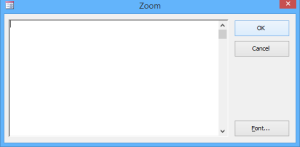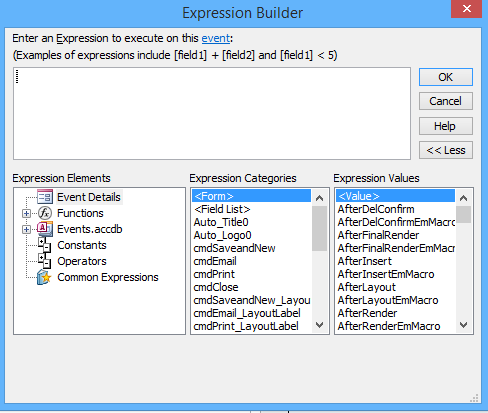Use These Great Shortcuts to Save Time in Access
by Avantix Learning Team | Updated October 14, 2022
Applies to: Microsoft® Access® 2010, 2013, 2016, 2019, 2021 and 365 (Windows)
Save time in Access using these great keyboard shortcuts. These will work in most versions of Access with minor variations. We're assuming you're already using standard shortcuts like Ctrl + P to print, Ctrl + S to save and Ctrl + C to copy.
Recommended article: How to Convert a Microsoft Access Report to PDF
Do you want to learn more about Microsoft Access? Check out our virtual classroom or in-person classroom Access courses >
Zoom
You can display a zoom dialog box in many objects in Access – in a field in a table in Datasheet View, in the criteria row or field row in a query and even in properties for tables, queries, forms and reports. Simply click where you want to zoom and press Shift + F2. A dialog box appears where you can enter data or an expression. You can change the font size in the zoom dialog to make it even easier to work.
Display the Expression Builder
You can use this shortcut in many objects in Microsoft Access as well – in the field row in a query and in specific properties for tables, queries, forms and reports. Simply click where you want to create an expression and press Ctrl + F2. Note that this shortcut does not work in a control in Design View in a form or report. You'll need to click in specific properties if you want to use this trick.
Close the current object
Press Ctrl + W.
Go to Form View in a form
In Design View, press Ctrl + period (.). If you keep pressing Ctrl + period (.), Access will move between the different views for the form. Alternatively, you can also press F5 to move from Design View to Form View.
Select all controls in a form or report
To select all controls in Design View in a form or report, press Ctrl + A.
Show/hide the Property Sheet
To show/hide the property sheet in Design View, press F4.
Show/Hide the Field List
To show/hide the field list in Design View in forms or reports, press Alt + F8.
Show/Hide the Navigation Pane
To show or hide the navigation pane, press F11.
Add or delete a record in Datasheet View or Form View
To add a new record in Datasheet View or Form View, press Ctrl + plus sign (+). To delete a record in Datasheet View or Form View, press Control + minus sign (-).
Quickly move between areas of the window
F6 is a great shortcut in Access. It works similarly in previous versions.
In Design View in tables, queries, forms and reports, keep pressing F6 to move between the design pane, lower window (tables and queries), properties (if open), the Navigation Pane (if open), the view controls in the Status bar and access keys on the Ribbon.
Subscribe to get more articles like this one
Did you find this article helpful? If you would like to receive new articles, JOIN our email list.
More resources
Key Features and Benefits of Microsoft Access
10 Techniques for Designing Forms in Microsoft Access
How to Convert a Microsoft Access Report to PDF (3 Ways)
How to Highlight Records or Values in a Microsoft Access Report Using Conditional Formatting
10 Useful Microsoft Access Shortcuts When You're Working with Controls on Forms and Reports
Related courses
Microsoft Access: Introduction
Microsoft Access: Intermediate / Advanced
Microsoft Access: Introduction to VBA (Visual Basic for Applications)
Our instructor-led courses are delivered in virtual classroom format or at our downtown Toronto location at 18 King Street East, Suite 1400, Toronto, Ontario, Canada (some in-person classroom courses may also be delivered at an alternate downtown Toronto location). Contact us at info@avantixlearning.ca if you'd like to arrange custom instructor-led virtual classroom or onsite training on a date that's convenient for you.
Copyright 2024 Avantix® Learning
You may also like
How to Replace Zeros (0) with Blanks in Excel
There are several strategies to replace zero values (0) with blanks in Excel. If you want to replace zero values in cells with blanks, you can use the Replace command or write a formula to return blanks. However, if you simply want to display blanks instead of zeros, you have two formatting options – create a custom number format or a conditional format.
What is Power Query in Excel?
Power Query in Excel is a powerful data transformation tool that allows you to import data from many different sources and then extract, clean, and transform the data. You will then be able to load the data into Excel or Power BI and perform further data analysis. With Power Query (also known as Get & Transform), you can set up a query once and then refresh it when new data is added. Power Query can import and clean millions of rows of data.
How to Freeze Rows in Excel (One or Multiple Rows)
You can freeze one or more rows in an Excel worksheet using the Freeze Panes command. If you freeze rows containing headings, the headings will appear when you scroll down. You can freeze columns as well so when you scroll to the right columns will be frozen.
Microsoft, the Microsoft logo, Microsoft Office and related Microsoft applications and logos are registered trademarks of Microsoft Corporation in Canada, US and other countries. All other trademarks are the property of the registered owners.
Avantix Learning |18 King Street East, Suite 1400, Toronto, Ontario, Canada M5C 1C4 | Contact us at info@avantixlearning.ca










